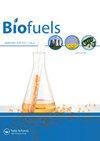基于混合工艺设计(CMPD)的柴油柴油/2-丙醇/1-己醇混合物性能优化研究
IF 2.6
4区 工程技术
Q3 ENERGY & FUELS
引用次数: 0
摘要
摘要当研究了两种或两种以上的混合物组合和一种或多种工艺因素时,基于混合物和工艺设计的组合优化工具显示出精确的预测和优化结果。因此,本研究采用CMPD法对预混20%芒果籽甲酯与80%柴油(MB20)的混合组分进行了优化;2-丙醇和1-己醇组分用可变负荷的工艺因素进行了优化。工艺因素负荷以25%的间隔从0到100%变化,而在每种情况下,酒精的量不允许超过15%(按体积计)。所设计的CMPD模型将CO、CO2、O2、HC和NOx等排放参数优化到最低水平,以使测试发动机产生最大的制动热效率(BTE)。所开发的优化模型实现了BTE的最大回归值(R2)0.9826,而CO获得了最低值(即0.9254 R2)。然而,该模型将BTE、BSFC、CO、CO2、O2、NOx和HC值优化为24.31%、0.452 千克/千瓦时,0.133%,3.397%,15.896%,283.268 ppm和17.879 ppm,可取值为0.884。这表明最佳燃料组合为80%的MB20、5%的2-丙醇和15%的1-己醇,负载为76.086%。本文章由计算机程序翻译,如有差异,请以英文原文为准。
Optimization of biodiesel/2-propanol/1-hexanol blends based on diesel engine performance using combined mixture-process design (CMPD)
Abstract The combined mixture and process design (CMPD)-based optimization tool showed precise prediction and optimized results when there were two or more mixture combinations and one or more process factors investigated. Therefore, in this study, the CMPD method was employed to optimize the mixture components of premixed 20% mango seed methyl ester mixed with 80% diesel (MB20); 2-propanol and 1-hexanol components were optimized with process factor of variable loads. The process factor load was varied from 0 to 100% at 25% intervals, whereas the amount of alcohol was not permitted to exceed 15% by volume in each case. The designed CMPD model optimized the emission parameters such as CO, CO2, O2, HC and NOx to their minimum levels to produce maximum brake thermal efficiency (BTE) from the test engine. The developed optimization model achieved a maximum regression value (R2) of 0.9826 for BTE while CO attained the lowest value (i.e. 0.9254 R2). However, the model optimized BTE, BSFC, CO, CO2, O2, NOx and HC values as 24.31%, 0.452 kg/kw.h, 0.133%, 3.397%, 15.896%, 283.268 ppm and 17.879 ppm, respectively, with the desirability of 0.884. This suggests the optimum fuel combination is 80% MB20, 5% 2-propanol, and 15% 1-hexanol with a 76.086% load.
求助全文
通过发布文献求助,成功后即可免费获取论文全文。
去求助
来源期刊

Biofuels-Uk
Energy-Renewable Energy, Sustainability and the Environment
CiteScore
5.40
自引率
9.50%
发文量
56
期刊介绍:
Current energy systems need a vast transformation to meet the key demands of the 21st century: reduced environmental impact, economic viability and efficiency. An essential part of this energy revolution is bioenergy.
The movement towards widespread implementation of first generation biofuels is still in its infancy, requiring continued evaluation and improvement to be fully realised. Problems with current bioenergy strategies, for example competition over land use for food crops, do not yet have satisfactory solutions. The second generation of biofuels, based around cellulosic ethanol, are now in development and are opening up new possibilities for future energy generation. Recent advances in genetics have pioneered research into designer fuels and sources such as algae have been revealed as untapped bioenergy resources.
As global energy requirements change and grow, it is crucial that all aspects of the bioenergy production process are streamlined and improved, from the design of more efficient biorefineries to research into biohydrogen as an energy carrier. Current energy infrastructures need to be adapted and changed to fulfil the promises of biomass for power generation.
Biofuels provides a forum for all stakeholders in the bioenergy sector, featuring review articles, original research, commentaries, news, research and development spotlights, interviews with key opinion leaders and much more, with a view to establishing an international community of bioenergy communication.
As biofuel research continues at an unprecedented rate, the development of new feedstocks and improvements in bioenergy production processes provide the key to the transformation of biomass into a global energy resource. With the twin threats of climate change and depleted fossil fuel reserves looming, it is vitally important that research communities are mobilized to fully realize the potential of bioenergy.
 求助内容:
求助内容: 应助结果提醒方式:
应助结果提醒方式:


